Advanced Redirects Module

What Are Redirects?
A redirect is a way to send both users and search engines from one web page to another.
The first URL is the source URL: the URL the user clicked, typed in, or otherwise requested. The second is the new destination URL.
So, when a site visitor reaches a URL with a redirection, their browser automatically jumps to a new address.
Redirects are often used for:
- broken pages
- pages you’ve deleted
- pages that were moved to new URLs
- pages that contain duplicated content
- pages on which you’re performing maintenance
Redirects are also useful in case you want to merge two or more pages into a single one.
By implementing redirects, you ensure that both human users and search engines will find the current page or the page with the most relevant and up-to-date information.
Why are Redirects Important?
Imagine a potential customer reaching your website, clicking on a link, and instead of finding the expected content, they encounter a 404 error page that tells them the page cannot be accessed.
It’s not the best first impression, and it may actually cause visitors to leave your site.
This is what happens when you move or delete a page and DON’T put a redirect in place.
One of the main reasons why you should implement redirects is that it allows you to forward traffic from one URL to another when the old URL no longer exists.
This is important because it improves the overall user experience, helping you prevent ending up with unhappy, confused, or frustrated users.
For SEO purposes, URL redirects are also important because they forward the authority of any links pointing to a page that has been moved or deleted. You won’t gain any authority from backlinks that point to a page that has been moved and is now triggering 404 errors.
Overview of the Advanced Redirects Module from Squirrly SEO
With Squirrly SEO’s Advanced Redirects Module, you can easily set up redirects, keep track of all redirections on your site, manage 404 errors, and more.
We’ll explain all these features in the upcoming sections.
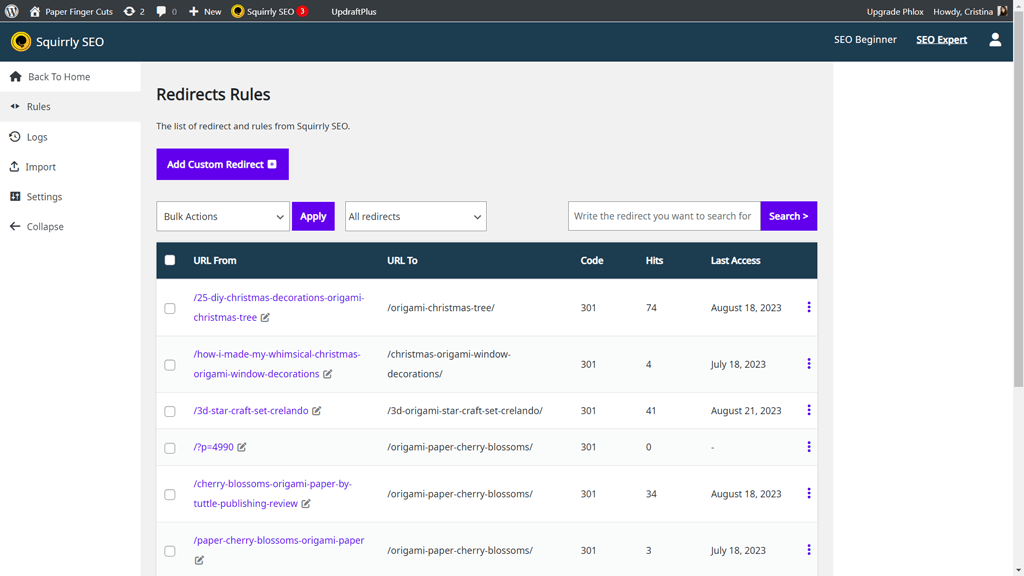
How to Access the Redirects Module from Squirrly SEO
Activating the Redirects Module in Squirrly SEO requires the Squirrly SEO – Advanced Pack plugin (the plugin gets installed/activated automatically and doesn’t cost you anything extra).
Here’s what you need to do:
1️⃣ Go to Squirrly SEO > Redirects
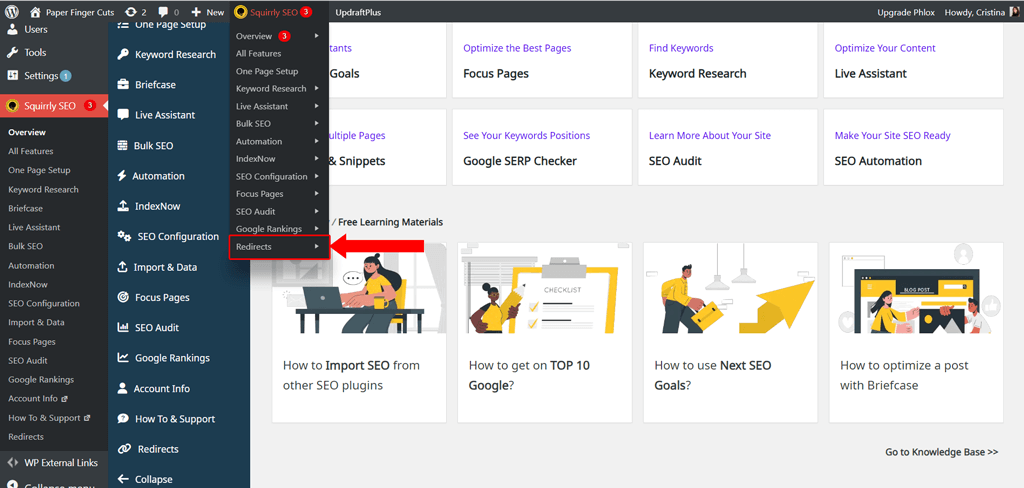
2️⃣ Clicking on Redirects will open the following panel. All you have to do is click on the Install/Activate Squirrly SEO – Advanced Pack button shown below.
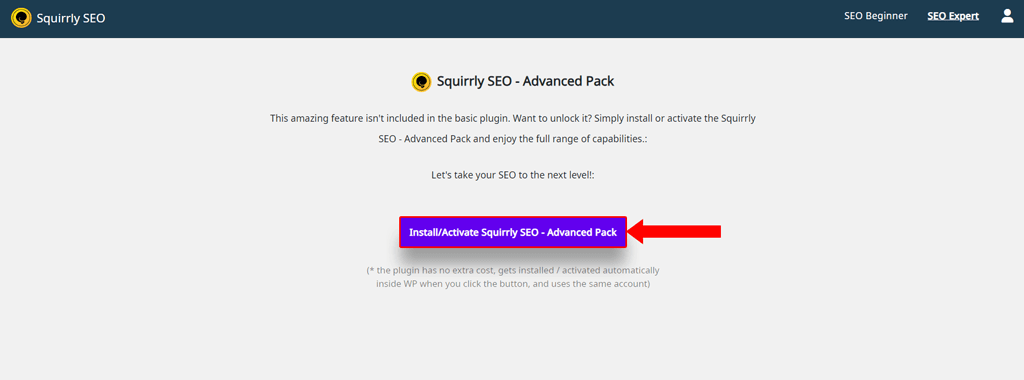
3️⃣ And that’s it! The plugin is now active for your website, and you will be able to see it in your list of Plugins.
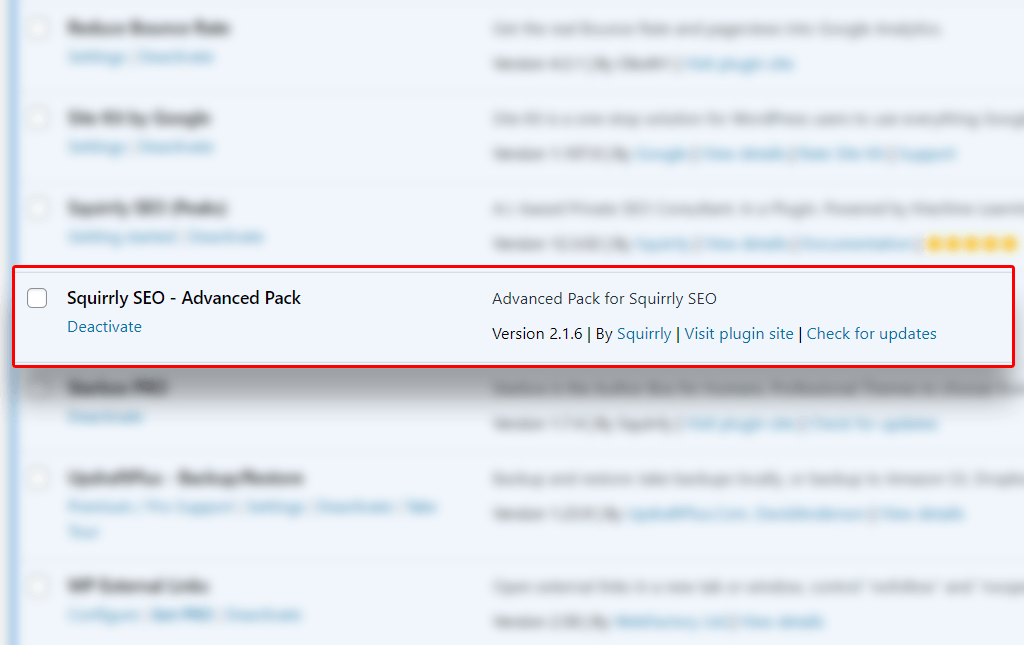
Redirects Rules
- To reach this section, go to: Squirrly SEO > Redirects > Rules
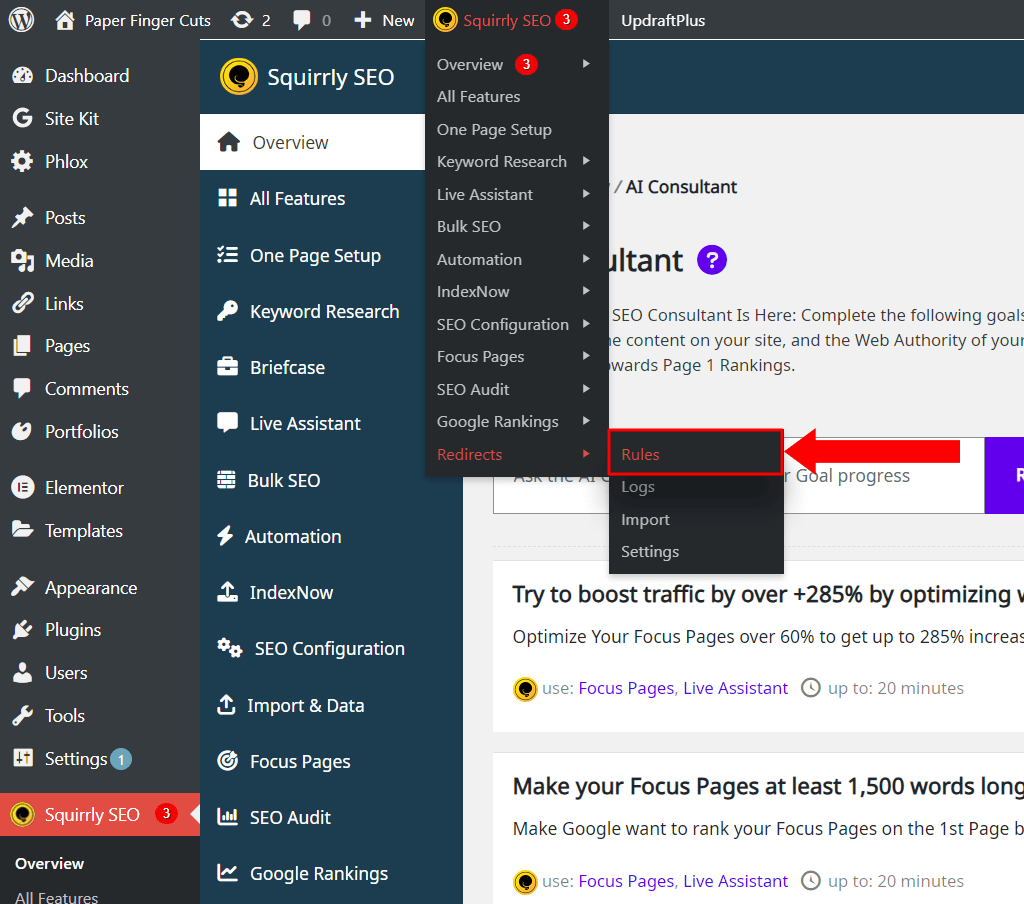
List of Redirects and Rules from Squirrly SEO
- To access this option, go to Squirrly SEO > Redirects > Rules
This feature provides a centralized view of redirects you’ve set up on your site, making it easier to manage, monitor, and edit or delete redirects as needed.
After activating the Redirects Module, Squirrly will attempt to automatically import previous changes related to slug modifications made on your website, and display them in this list. In order to see redirects you’ve set up using other plugins, use the Import feature from Squirrly SEO > Redirects > Import
Here’s a breakdown of what you can see in the Redirect Rules list:

URL From:
This is the original URL that has been set up to redirect from. It displays the old or previous link that visitors or search engines might have accessed.
URL To:
This shows the destination URL to which visitors are redirected. It represents the new or updated link users and search engines are directed to upon accessing the original URL.
Code:
This indicates the type of redirect in place, displayed as the corresponding HTTP status code. Commonly used codes are “301” (Moved Permanently) or “302” (Temporary Redirect). Each code conveys specific information about the redirect’s nature to browsers and search engines.
Hits:
This column tallies the number of times the redirect has been accessed. Not only does it measure how frequently the old URL is visited, but it also provides a glimpse into the traffic directed through that redirect.
Note that if you make changes to the redirect using the “Edit” option, this count will reset.
To see these numbers, ensure the “Track Redirect Hits” option is ON. You can find this setting in Squirrly SEO > Redirects > Settings.
Last Access:
Here, you’ll find the most recent date and time when the redirect was accessed.
For each redirect in the list, you have the following options:
- Edit Redirect: This allows you to update the details of an already set-up redirect. For example, if the destination link has changed, you can update the “URL To” field. Note that making changes will reset the count in the Hits column.
- Disable Redirect: This option lets you temporarily deactivate a redirect. It pauses the redirect function but retains its details, so you can enable it again if needed.
- Delete Redirect: If a redirect is no longer necessary, use this to permanently remove a specific redirect and redirect rule, ensuring it’s deactivated.
To access these options, look for the three dots next to the redirect entry you’re interested in. By clicking on them, you can edit, disable, or delete the redirect as needed.
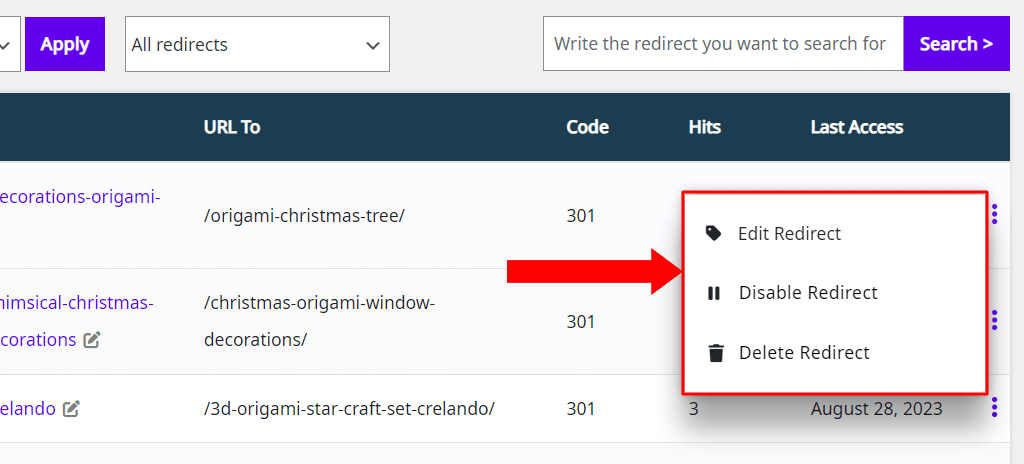
Add Custom Redirect
- To reach this section, go to Squirrly SEO > Redirects > Rules and click on Add Custom Redirect.
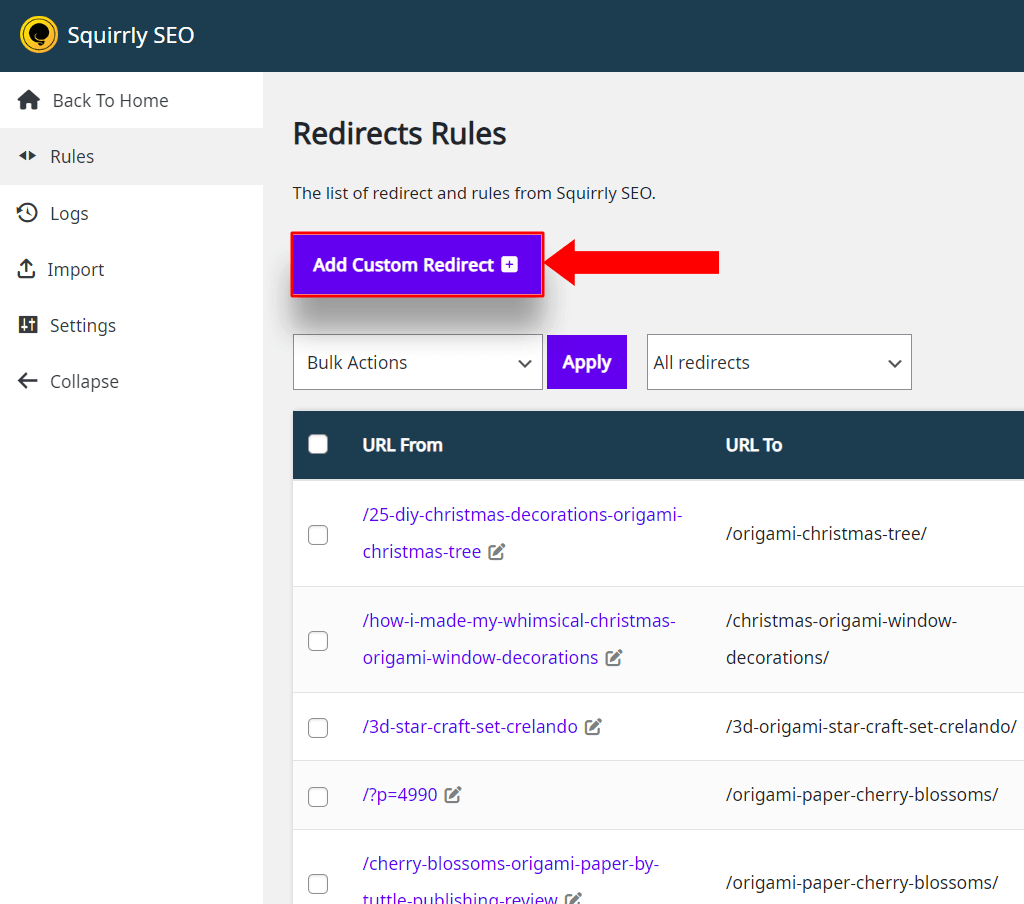
Clicking on Add Custom Redirect will open a new panel with the following options:
Redirect From
This is where you add the original URL or the URL from which you want to redirect visitors.
Redirect To
This is the destination URL or the URL where you want to send the visitors to. This is where users will be directed when they access the original URL.
URL Matching
This determines how strictly the “Redirect From” URL should match with the “Redirect To” URL. Here, you can choose from three options:
- Exact URL Match: Matches the query parameters exactly defined in your source, in any order.
- Ignore all query parameters: The redirect occurs regardless of any query parameters. To identify a URL parameter, look at the portion of the URL that comes after a question mark (?). When you select this option, both
example.com/old-page?color=redandexample.com/old-page?size=largewould redirect to the specified “Redirect To” URL. - Ignore and pass all query parameters: The redirect will overlook the query parameters in the matching process but will pass them to the destination URL. So,
example.com/old-page?color=redwould redirect toexample.com/new-page?color=red.
Note! The settings you make here will overwrite the default settings you’ve enabled in Squirrly SEO > Redirects > Settings.
Redirect Type
The next step is to choose the redirect type you want. In Squirrly SEO, a redirect can be set as a:
- Permanent redirects: 301, 308
301 – Moved Permanently: This is the most commonly used redirect type. It tells search engines and browsers that the original URL has permanently moved to a new location. It’s ideal for long-term URL changes.
308 – Permanent Redirect: A 308 permanent redirect response code informs search engines and web browsers that a URL has permanently moved to a new location and that the original URL will no longer be accessible.
- Temporary redirects: 302, 307.
302 – Found: A 302 redirect indicates a temporary move or a temporary alternate version of a page. It’s useful when you plan to bring the original page back or if you want to test a new page without permanently replacing the old one.
307 – Temporary Redirect: A 307 redirect indicates that the redirection is only temporary and the original URL will be accessible again in the future. This type of redirect is useful when you need to perform website maintenance or make updates to your pages while ensuring minimal disruption to your users.
With Squirrly, you can also choose 404 – Page Not Found as the Redirect Type.

Regex Match
When using normal redirects, you add a single source URL and a single target/destination URL. In this case, one source always points to one destination.
However, there are times when multiple sources need to be directed to a single destination. For these situations, you can use REGEX Redirects.
These redirections employ Regular Expressions to match multiple source URLs and redirect all of them to a designated destination.
Activate this if using regular expression (Regex) redirects.
We strongly recommend that you ONLY use REGEX redirects if you’re experienced with them and 100% know what you’re doing. If you’re new to regular expressions, it’s best to leave this option turned OFF to avoid potential issues.
Note! If Using SEO Beginner Mode, click on More Options >> to see this setting
Ignore Case
URLs can be case-sensitive. Check or activate this option if you want the redirect to function regardless of letter casing. This means example.com/Old-Page and example.com/old-page would be treated identically for redirection purposes.
If using SEO Beginner Mode, click on More Options >> to see this setting
Note! The settings you make here will overwrite the default settings you’ve enabled in Squirrly SEO > Redirects > Settings.
Ignore Slash
Activate this if you want the system to treat URLs as identical regardless of a trailing slash. This means example.com/old-page and example.com/old-page/ would redirect to the same destination.
If using SEO Beginner Mode, click on More Options >> to see this setting
Note! The settings you make here will overwrite the default settings you’ve enabled in Squirrly SEO > Redirects > Settings.
Complete Adding a New Redirect
When you’re happy with your settings, click on “Add Redirect” to complete the process.

Bulk Actions in Redirects Rules
- To reach this section, go to Squirrly SEO > Redirects > Rules > Bulk Actions
If you have a lot of redirects to manage, then deleting them one by one can be very time-consuming.
That is why we’ve included Bulk Actions inside the Redirects Rules panel, allowing you to delete multiple redirects at once.
To use this, select the redirects you no longer need, then go to Bulk Actions and select “Delete” from the drop-down menu. Finally, click on the button that reads Apply.

Filters in Redirect Rules
Easily sift through your “Redirect List and Rules” by using the filters provided. By selecting a specific filter, you can instantly view only those types of redirects.
Filter Options:
- All Redirects
- Custom Redirects: See only the redirects you’ve personally customized when adding a new redirect using Squirrly’s Redirects feature.
- Post Redirects: Display redirects you’ve previously set up using Squirrly’s Snippet feature before starting using the Redirects Module.
- Slug Changed Redirects: Display redirects that were set up due to slug modifications.
Simply click on your desired filter to narrow down and view the specific redirects you’re interested in.

You can also utilize the search bar to search for redirects.
CSV Export for Redirects
- To reach this section, go to: Squirrly SEO > Redirects > Rules > Export Redirects
Click on Export Redirects to download and save your logged redirects in a CSV (Comma Separated Values) format.

Redirects Logs
- To reach this section, go to: Squirrly SEO > Redirects > Logs
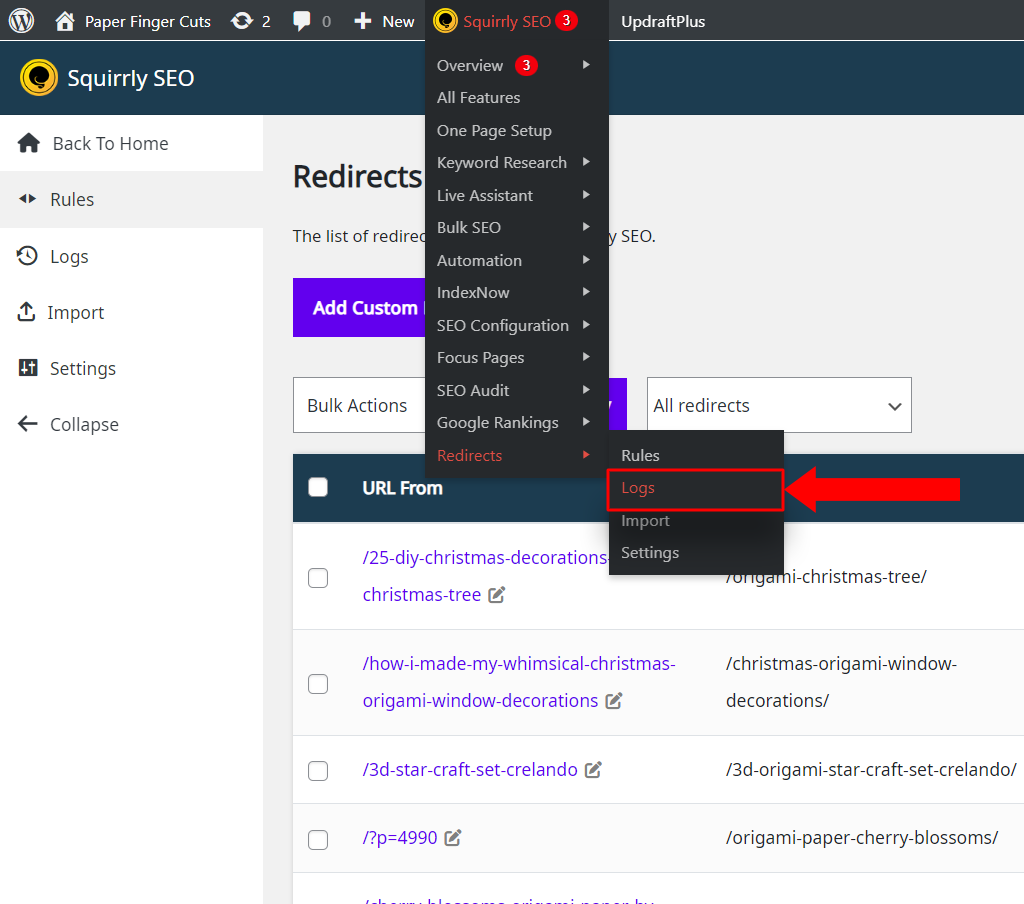
“Redirect Logs” allows you to keep a log with all the redirects and monitor/review all the redirections taking place on your site.
Every time a redirect happens on your site, an entry is made in the logs. Each entry contains:
- URL from: The original URL that triggered the redirect.
- URL to: The destination URL where users are redirected.
- Code: The type of the redirect (e.g., 301 for permanent redirects, 307 for temporary redirects, etc.)
- Access: The date and time when the original URL was accessed, leading to the redirect.
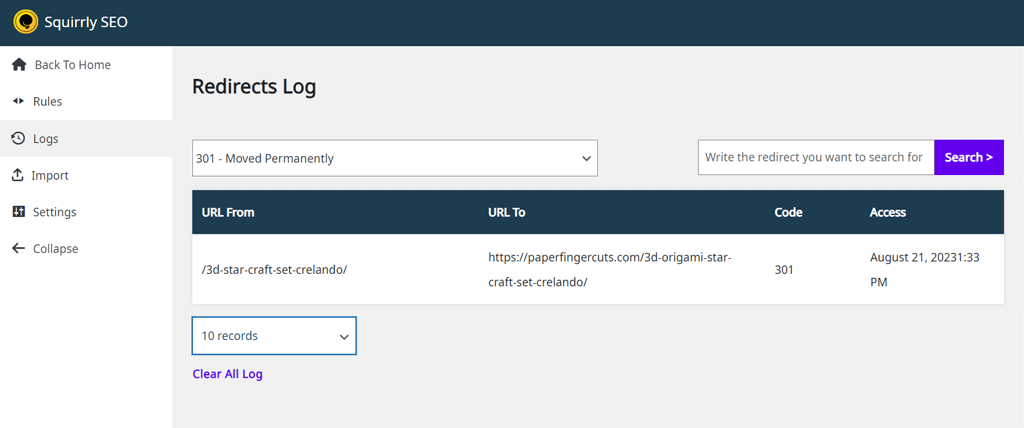
You can also filter through your Redirect Logs to quickly identify specific types of redirects using the filters shown below. Click on the desired filter option to view only the logs for that specific redirect type.

You can also utilize the search bar to search for redirects. Simply type the redirect you want to search for, like 301, for example.
Last but not least, you can choose how many redirect entries (records) you want to see on one page in the Redirects Log using the options shown below.
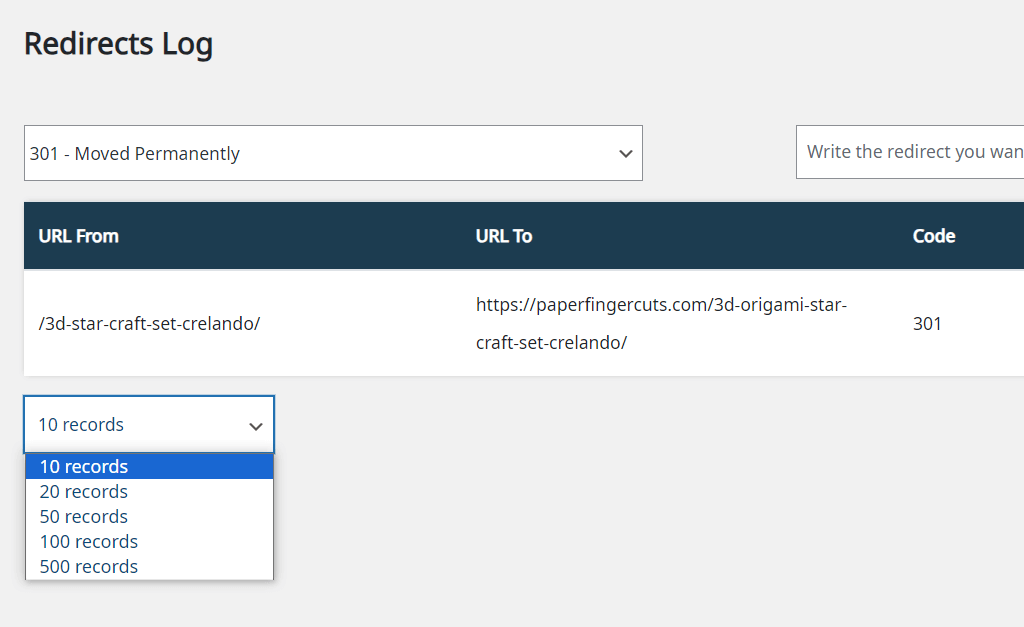
And if you want to clear all log entries at once, use the Clear All Log option.
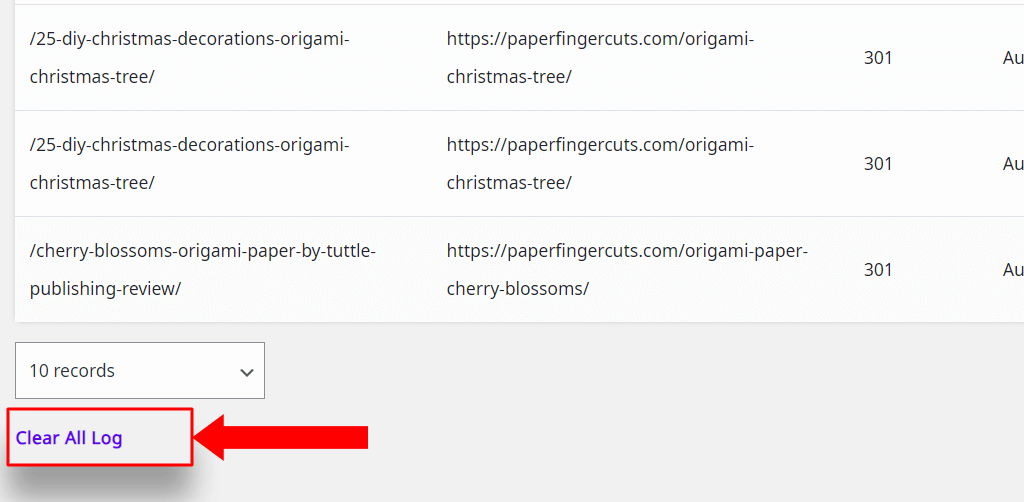
404 Monitor
Go to Squirrly SEO > Redirects > Redirects Log and select the “404 – Page Not Found” filter. This will display the 404 error pages and the specific dates and times they were accessed.
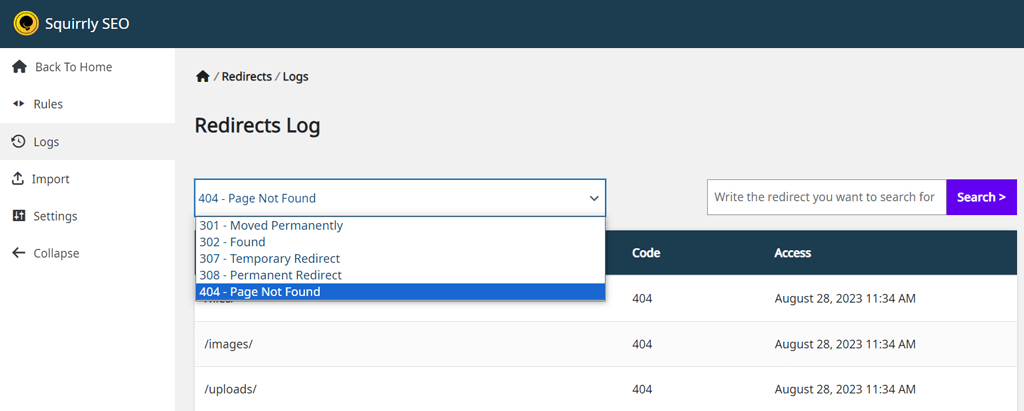
To see these pages, ensure the “404 Monitor” option is ON. You can find this setting in Squirrly SEO > Redirects > Settings.
Import Redirects
- To reach this section, go to: Squirrly SEO > Redirects > Import

The “Import Redirects” feature simplifies the task of moving or merging your redirects from other SEO plugins. Whether you’re just starting with our tool or consolidating your SEO efforts, this feature ensures a smooth transition.
Using the “Import Redirects” button, you can import redirects you’ve set up using ANY of the following plugins:
- Eps 301 Redirects
- All in One SEO
- Redirection
- Rank Math
- Quick Redirects
- Squirrly SEO
- SEO Framework
- SEO Press
- Yoast SEO
Additionally, you can import redirects from WordPress Core (Slug Changes)

⚠️ Attention: We recommend importing redirects from other plugins immediately after activating the Redirects feature in Squirrly SEO and before setting up any new redirects.
That’s because the imported redirects will overwrite existing redirects if there are the same paths.
To create a backup of your current redirects, follow these steps:
- Navigate to: Squirrly SEO > Technical SEO > Import & Data > Backup Settings & SEO.
- Use the “Backup Redirects” option.
This will allow you to download and save a copy of your existing redirects.
Redirects Settings
- To reach this section, go to Squirrly SEO > Redirects > Settings
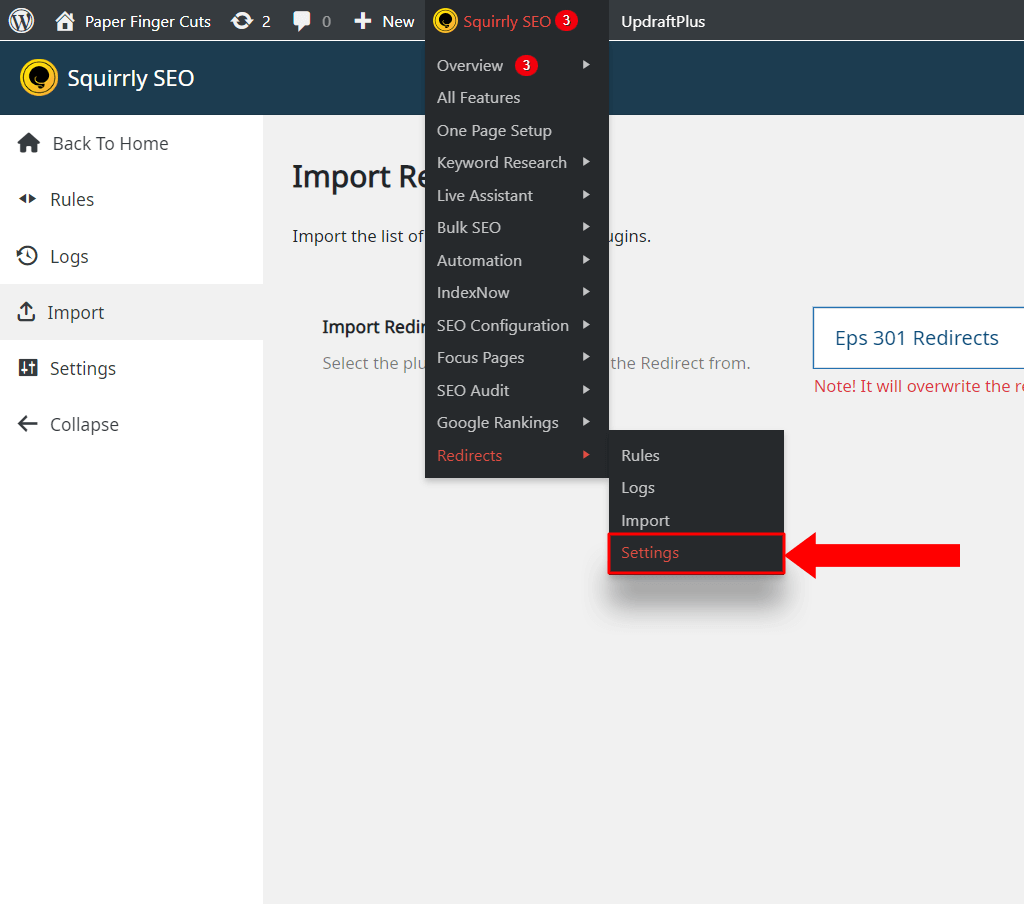
Here’s what you can set up and customize in this section of the Advanced Redirects Module:
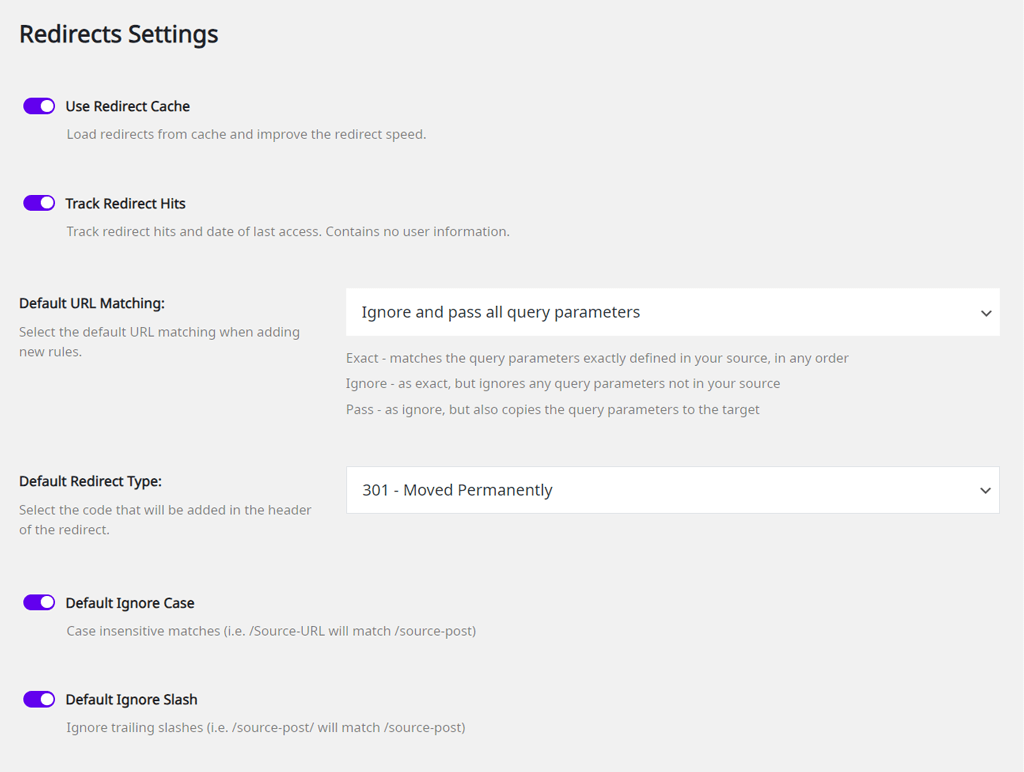
Use Redirect Cache
Activate this option in order to load redirects from cache and improve the redirect speed.
By default, this is turned OFF.
Track Redirect Hits
Activate this option to track redirect hits (the number of times the redirect has been accessed) and the date and time when the original URL was accessed, leading to the redirect. If you activate this, you’ll view redirect hits numbers in Squirrly SEO > Redirects > Rules
IMPORTANT: This feature doesn’t collect or store any personal user information.
Default URL Matching:
Select the default URL matching when adding new rules. You can choose from:
- Exact URL Match: Matches the query parameters exactly defined in your source, in any order.
- Ignore all query parameters: The redirect occurs regardless of any query parameters. To identify a URL parameter, look at the portion of the URL that comes after a question mark (?). When you select this option, both
example.com/old-page?color=redandexample.com/old-page?size=largewould redirect to the specified “Redirect To” URL. - Ignore and pass all query parameters: The redirect will overlook the query parameters in the matching process but will pass/copy them to the destination URL. So,
example.com/old-page?color=redwould redirect toexample.com/new-page?color=red.
NOTE! This setting is only available in SEO Expert Mode. You can toggle between SEO Beginner Mode and SEO Expert Mode from the top right corner of your screen.
Default Redirect Type:
Select the code that will be added in the header of the redirect by default. You can choose from:
- 301 – Moved Permanently
- 302 – Found
- 307 – Temporary Redirect
- 308 – Permanent Redirect
- 404 – Page Not Found
NOTE! This setting is only available in SEO Expert Mode. You can toggle between SEO Beginner Mode and SEO Expert Mode from the top right corner of your screen.
Default Ignore Case:
- activate for case-insensitive matches
URLs can be case-sensitive. Check or activate this option if you want the redirect to function regardless of letter casing by default. This means example.com/Old-Page and example.com/old-page would be treated identically for redirection purposes.
NOTE! This setting is only available in SEO Expert Mode. You can toggle between SEO Beginner Mode and SEO Expert Mode from the top right corner of your screen.
Default Ignore Slash:
- activate to ignore trailing slashes
Activate this if you want Squirrly’s redirect system to treat URLs as identical regardless of a trailing slash by default. This means example.com/old-page and example.com/old-page/ would redirect to the same destination.
NOTE! This setting is only available in SEO Expert Mode. You can toggle between SEO Beginner Mode and SEO Expert Mode from the top right corner of your screen.
Post Types Settings
- To reach this section go to Squirrly SEO > Redirects > Settings > Post Types Settings

Redirect Changed Paths:
This feature enables you to automatically redirect visitors to the new path when a path has been updated in the Post Editor.
Choose the type(s) of posts you wish to monitor for changes in path:
- Post
- Page
- Attachment
- E Landing Page
Redirect Broken URLs:
Activate this setting to redirect any not-found posts to a designated URL (you can choose your Home page, for example). This will help you prevent 404 error pages.
Logging
- To reach this section, go to Squirrly SEO > Redirects > Settings > Logging
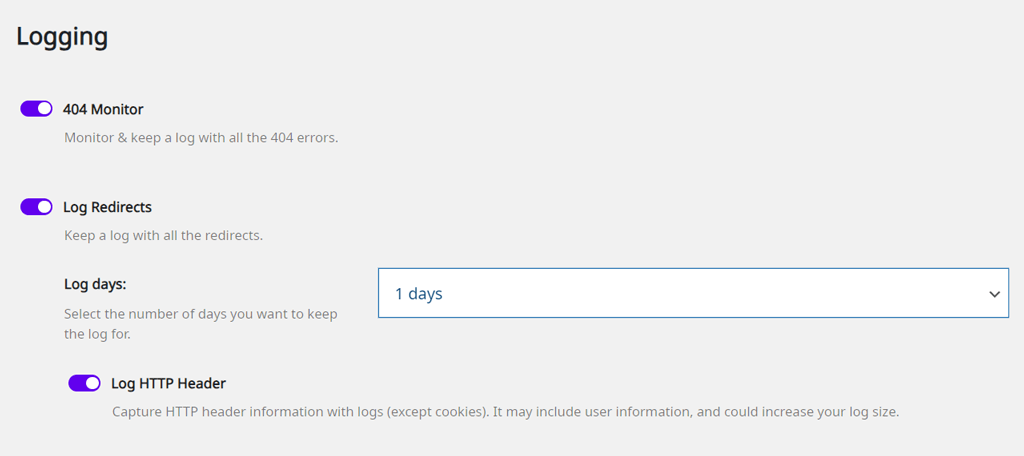
404 Monitor
Activate this option to monitor and record all 404 errors on your site. To view these records, go to Squirrly SEO > Redirects > Logs.
Log Redirects
Activate this option to keep a log with all the redirects. To view these entries, go to Squirrly SEO > Redirects > Logs.
By default, this is turned OFF.
Log Days
This option lets you decide how long you want to retain the Redirects logs.
Options:
- Keep logs for 1 day.
- Keep logs for 7 days.
- Keep logs for 30 days.
- Keep logs for 60 days.
- Keep logs for 90 days.
- Keep logs for 365 days.
Simply select the desired duration from the provided options. Squirrly will automatically delete the Redirects logs based on your preferences.
NOTE! This setting is only available in SEO Expert Mode. You can toggle between SEO Beginner Mode and SEO Expert Mode from the top right corner of your screen.
Log HTTP Header
Activate this option to capture HTTP header information with logs (except cookies). Note that this might contain user-related data and can increase the log size.
NOTE! This setting is only available in SEO Expert Mode. You can toggle between SEO Beginner Mode and SEO Expert Mode from the top right corner of your screen.
Notes Regarding Functionality Range
In the current version of Squirrly SEO, there are some redirect functionalities that are NOT supported. Below are the specifics and the suggested solutions:
1. Redirecting www to non-www
This function isn’t currently available. However, you can follow the tutorial provided here for a solution.
2. Redirecting http to https
Again, this isn’t something that Squirrly SEO can handle natively right now. However, there’s an easy workaround using a WordPress plugin. Simply install and use the following plugin: Really Simple SSL.
Should we include these features in the plugin in the future, we will definitely let you know. Remember, you can always explore and influence upcoming functionalities by submitting and voting for your desired features on our Roadmap.
Another thing you should know is that Squirrly SEO does NOT support the redirection of subdomains.
This means, if your site previously had a ‘www.’ subdomain and now doesn’t, Squirrly’s Redirects feature cannot remove this subdomain for you. Note that ‘www.’ is NOT considered a local domain.
Types of Supported Redirects in Squirrly SEO:
- Local to Local URL: This allows you to redirect from one local URL on your site to another local URL.
- Local to External URL: This enables a redirect from a local URL on your site to an external website.
However, please note that redirecting from an External URL to a Local URL is NOT supported.
We’ve Covered Everything You Need to Know about Squirrly’s Redirects Module
Remember, redirects are not just about moving content around. They contribute to an overall better user experience and impact how websites are crawled and indexed by Google.
By using the Advanced Redirects Module from Squirrly SEO, you can easily set up the proper redirects, keep a log of all redirects implemented on your site, monitor 404 errors, and more.



0 Comments